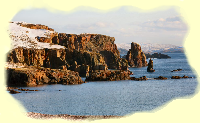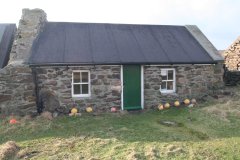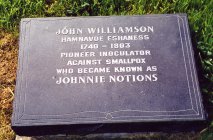

Within Shetland, Johnnie Notions will be best remembered as the crofter from Hamnavoe, who created a serum, with which he inoculated over 3000 people without loosing of a single patient.
Outside the islands his name will mean little to people, and will probably find no more recognition, than that given to, two other likeminded inventors, Benjamen Jesty from Dorset in 1774 and a Mr. 'No-name' from Berkshire in 1754, who inoculated people without the knowledge of each other, although many miles separated these three men, they had the same ideals and purpose as a goal.
Because of Shetlands remote location, its people had little or no immunity to the diseases brought in by sailors and other travellers to the islands. The biggest scourge was between 1700 and 1800 when outbreaks of smallpox were occurring, roughly every 20 years, causing widespread desolation and claiming in the region of a quarter, to a third of the population each time. John Williamson was born in 1740, when Eshaness was suffering from the effects of one such epidemic.
John Williamson was a weaver, who, although uneducated, was a very clever man and he could turn his hand to almost anything, including carpentry, clock mending and for a time he worked as a blacksmith. He was for ever having bright ideas and over the years invented some useful and some not so useful things. He particularly enjoyed experimenting with mechanical inventions and eventually the local folk nicknamed him 'Johnnie Notions'.

In 1792 the Rev. Andrew Dishington, a minister at the time in Yell described Johnnie Notions methods of vaccination as follows, and I take the liberty of quoting him.
"He was careful to provide the best matter and keeps it a long time before he puts it to use - sometimes 7 or 8 years. And, in order to lessen its virulence, he first dries it in peat smoke, and then puts it under the ground, covered with camphor .... He uses no lancet in performing the operation, but, by a small knife, made by his own hands, he raises a very little of the outer skin of the arm, so that no blood follows: then puts in a very small quantity of the matter, which he immediately covers with the skin, that had been thus raised. The plaister he uses, for healing the wound, is a bit of cabbage leaf."
